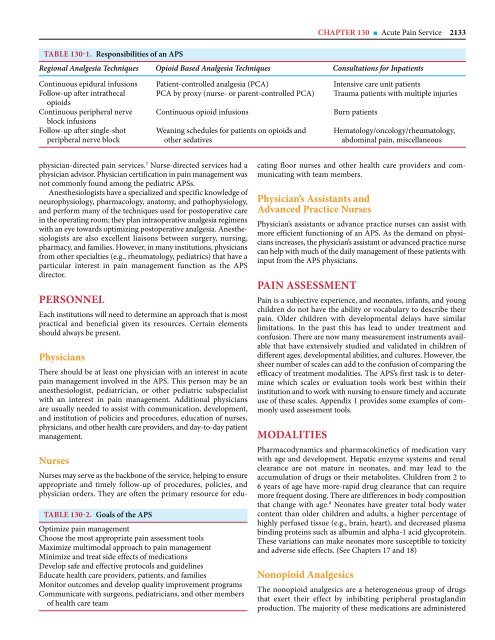Chapter 130
Create successful ePaper yourself
Turn your PDF publications into a flip-book with our unique Google optimized e-Paper software.
TABLE <strong>130</strong>-1. Responsibilities of an APS<br />
CHAPTER <strong>130</strong> ■ Acute Pain Service 2133<br />
Regional Analgesia Techniques Opioid Based Analgesia Techniques Consultations for Inpatients<br />
Continuous epidural infusions<br />
Follow-up after intrathecal<br />
opioids<br />
Continuous peripheral nerve<br />
block infusions<br />
Follow-up after single-shot<br />
peripheral nerve block<br />
Patient-controlled analgesia (PCA)<br />
PCA by proxy (nurse- or parent-controlled PCA)<br />
Continuous opioid infusions<br />
Weaning schedules for patients on opioids and<br />
other sedatives<br />
Intensive care unit patients<br />
Trauma patients with multiple injuries<br />
Burn patients<br />
Hematology/oncology/rheumatology,<br />
abdominal pain, miscellaneous<br />
physician-directed pain services. 7 Nurse-directed services had a<br />
physician advisor. Physician certification in pain management was<br />
not commonly found among the pediatric APSs.<br />
Anesthesiologists have a specialized and specific knowledge of<br />
neurophysiology, pharmacology, anatomy, and pathophysiology,<br />
and perform many of the techniques used for postoperative care<br />
in the operating room; they plan intraoperative analgesia regimens<br />
with an eye towards optimizing postoperative analgesia. Anesthe -<br />
siolo gists are also excellent liaisons between surgery, nursing,<br />
pharmacy, and families. However, in many institutions, physicians<br />
from other specialties (e.g., rheumatology, pediatrics) that have a<br />
particular interest in pain management function as the APS<br />
director.<br />
PERSONNEL<br />
Each institutions will need to determine an approach that is most<br />
practical and beneficial given its resources. Certain elements<br />
should always be present.<br />
Physicians<br />
There should be at least one physician with an interest in acute<br />
pain management involved in the APS. This person may be an<br />
anesthesiologist, pediatrician, or other pediatric subspecialist<br />
with an interest in pain management. Additional physicians<br />
are usually needed to assist with communication, development,<br />
and institution of policies and procedures, education of nurses,<br />
physicians, and other health care providers, and day-to-day patient<br />
management.<br />
Nurses<br />
TABLE <strong>130</strong>-2. Goals of the APS<br />
Optimize pain management<br />
Choose the most appropriate pain assessment tools<br />
Maximize multimodal approach to pain management<br />
Minimize and treat side effects of medications<br />
Develop safe and effective protocols and guidelines<br />
Educate health care providers, patients, and families<br />
Monitor outcomes and develop quality improvement programs<br />
Communicate with surgeons, pediatricians, and other members<br />
of health care team<br />
Nurses may serve as the backbone of the service, helping to ensure<br />
appropriate and timely follow-up of procedures, policies, and<br />
physician orders. They are often the primary resource for educating<br />
floor nurses and other health care providers and communicating<br />
with team members.<br />
Physician’s Assistants and<br />
Advanced Practice Nurses<br />
Physician’s assistants or advance practice nurses can assist with<br />
more efficient functioning of an APS. As the demand on physicians<br />
increases, the physician’s assistant or advanced practice nurse<br />
can help with much of the daily management of these patients with<br />
input from the APS physicians.<br />
PAIN ASSESSMENT<br />
Pain is a subjective experience, and neonates, infants, and young<br />
children do not have the ability or vocabulary to describe their<br />
pain. Older children with developmental delays have similar<br />
limitations. In the past this has lead to under treatment and<br />
confusion. There are now many measurement instruments available<br />
that have extensively studied and validated in children of<br />
different ages, developmental abilities, and cultures. However, the<br />
sheer number of scales can add to the confusion of comparing the<br />
efficacy of treatment modalities. The APS’s first task is to determine<br />
which scales or evaluation tools work best within their<br />
institution and to work with nursing to ensure timely and accurate<br />
use of these scales. Appendix 1 provides some examples of commonly<br />
used assessment tools.<br />
MODALITIES<br />
Pharmacodynamics and pharmacokinetics of medication vary<br />
with age and development. Hepatic enzyme systems and renal<br />
clearance are not mature in neonates, and may lead to the<br />
accumulation of drugs or their metabolites. Children from 2 to<br />
6 years of age have more-rapid drug clearance that can require<br />
more frequent dosing. There are differences in body composition<br />
that change with age. 8 Neonates have greater total body water<br />
content than older children and adults, a higher percentage of<br />
highly perfused tissue (e.g., brain, heart), and decreased plasma<br />
binding proteins such as albumin and alpha-1 acid glycoprotein.<br />
These variations can make neonates more susceptible to toxicity<br />
and adverse side effects. (See <strong>Chapter</strong>s 17 and 18)<br />
Nonopioid Analgesics<br />
The nonopioid analgesics are a heterogeneous group of drugs<br />
that exert their effect by inhibiting peripheral prostaglandin<br />
production. The majority of these medications are administered
















